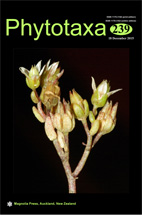Abstract
As part of a taxonomic revision of the genus Massonia, we here clarify concepts of Massonia echinata, M. latebrosa and M. tenella—all frequently misunderstood or reduced to synonymy. We discuss their history, biology, habitat preferences and distribution. Our study also shows that the current concept of M. echinata, including M. angustifolia and M. lanceolata as synonyms, includes two unpublished species which we here describe as M. pseudoechinata and M. roggeveldensis. A new combination in Massonia is proposed for Haemanthus sessiliflorus.

